Donated Trees in Peace Memorial Park
The legacy of peace trees donated from home and abroad
The verdant trees in Peace Memorial Park are a symbol of the restoration of Hiroshima following the damage and destruction caused by the atomic bomb. Amongst these trees are many that were donated from across Japan and overseas, or commemorative trees; in the lead-up to the development of Peace Memorial Park in 1954, the Mayor of Hiroshima reached out to mayors across Japan, asking for donations of trees. This was the catalyst for donations from across Japan, as well as from overseas.
The powerful ideas and hopes of those who donated the trees and those who cared for them before us are conveyed through these trees and it is of great importance that we continue to protect them as symbols of both restoration and peace.
We hope that you will use this page to share the history of these donated trees far and wide, continuing their legacy well into the future.
Provided on this page is information about those trees whose background and other details have been collated from surviving City documents and from records and memories kindly supplied to us by residents.
We will update and share further information here as we continue collecting and collating the stories behind donated trees in Peace Memorial Park. If you have any information about donated trees, we would love to hear from you.
Database of donated trees (includes commemorative trees)
|
Reference code |
Species/Cultivar |
Year donated |
Donor/Further information |
|---|---|---|---|
| A-13 | Cinnamomum camphora | 1968 | All Japan Ryokan Hotel Association |
| A-18 | Butia yatay | 1965 | Hiroshima Printing Industry Association |
| A-71 | Cinnamomum camphora | 1947 | The First Peace Festival (Mayor Hamai) |
| A-93 | Cycas revoluta | 1968 | Commemorative Tree Planting for Land Construction Week |
| A-112, other | Camellia japonica | 1982 | The Nagasaki Prefectural Hibakusha Health Book Association and the Nagasaki Prefectural Mobilized Student Victims Association |
| A-A50-1(1) | Ludmilla | 1979 | The Czechoslovakian Government |
| A-A50-1(2) | Kronenbourg | 〃 | 〃 |
| A-A50-1(3) | Norita | 〃 | 〃 |
| A-A50-1(4) | Tahiti | 〃 | 〃 |
| A-A50-1(5) | Pussta (New Daily Mail) | 〃 | 〃 |
| A-A50-1(6) | Sea Pearl | 〃 | 〃 |
| A-A50-1(7) | Rose Gaujard | 〃 | 〃 |
| A-A50-1(8) | Piccadilly | 〃 | 〃 |
| A-A50-1(9) | King’s Ransom | 〃 | 〃 |
| A-A50-2(1) | Träumerei | 1977 | The City of Hamilton, Canada |
| A-A50-2(2) | Scherzo | 〃 | 〃 |
| A-A50-3 | Rosa x damascena | 2010 | The City of Kazanlak, Republic of Bulgaria |
| A-A50-4 | Spanish Beauty | 1977 | The Japan Rose Society Chugoku Branch |
| A-A50-5 | Peace | 1972 | Campaign for Nuclear Disarmament, United Kingdom |
| B-1, other | Nerium oleander | 1974 | The Norinchukin Bank |
| B-4 | Pinus thunbergii | 1963 | Association of People from Shimane Prefecture Residing in Hiroshima |
| B-5 | Pinus densiflora | 〃 | 〃 |
| B-13 | Pinus thunbergii | 1967 | Hiroshima Tomochi Kai |
| B-14 | Pinus densiflora | 〃 | 〃 |
| B-49, other | Ginkgo biloba | 1971 | Tokyo Federation of A-Bomb Sufferers Organizations (Toyukai) |
| B-58,C-207, other | Prunus x yedoensis | 1959 | The Hiroshima Restoration Exposition |
| B-197 | Cinnamomum camphora | 2004 | Hiroshima Branch of All Japan Construction, Transport and General Workers' Union |
| B-199 | Cinnamomum camphora | 1980 | Atomic Bomb Sufferers Association in Katsushika City, Tokyo |
| B-205 | Cinnamomum camphora | 1975 | Atomic Bomb Sufferers Association in Edogawa City, Tokyo |
| B-218 | Prunus x yedoensis | 2010 | Mairead Corrigan Maguire and others |
| B-219 | Cryptomeria japonica var. radicans | 1978 | The Hiroshima Shinkin Bank |
| B-229, other | Prunus x yedoensis | 2009~2011 | 120th Anniversary of the Establishment of Hiroshima Municipal Administration Commemorative Project |
| B-B21-1 | Duftwolke | 1968 | The West German Government |
| B-B21-2(1) | Piccadilly | 1970 | The British Government |
| B-B21-2(2) | Copper Pot | 〃 | 〃 |
| B-B21-2(3) | Wendy Cussons | 〃 | 〃 |
| B-B21-2(4) | King’s Ransom | 〃 | 〃 |
| B-B21-2(5) | Ernest H. Morse | 〃 | 〃 |
| B-B21-2(6) | Blue Moon | 〃 | 〃 |
| B-B21-2(7) | Peace | 〃 | 〃 |
| B-B21-2(8) | Queen Elizabeth | 〃 | 〃 |
| B-B21-2(9) | Diorama | 〃 | 〃 |
| B-B21-2(10)⑽ | Birmingham Post | 〃 | 〃 |
| B-B21-3 | Dr. Albert Schweitzer | 1970 | The Dutch Government |
| B-B21-4 | Souvenir d’ Anne Frank | 1989 | Yamamuro Kenji |
| B-B21-5 | Friedenspark Hiroshima | 1999 | The City of Eltville, Germany |
| C-8, other | Juniperus chinensis 'Kaizuka' | 1948 | Toyo Kogyo |
| C-81, other | Michelia compressa | 1962 | The Hiroshima War Disaster Consolation Society |
| C-83 | Phoenix canariensis | 1960 | The Japan Electric Association |
| C-233 | Lagerstroemia indica | 2001 | Choi Sang-yong Ambassador of the Republic of Korea to Japan |
| C-234 | Pinus koraiensis | 2015 | Korea-Japan Forum for the Future |
| E-3, other | Prunus x yedoensis | 1956 | The 5th Class of Graduates from the Hiroshima Municipal Commercial High School |
| F-78 | Pinus thunbergii | 1958 | Yoshimoto Juichi (Hiroshima Citizen) |
| F-88, other | Ulmus davidiana var. japonica | 1954 | The City of Sapporo, Hokkaido |
| F-115, other | Prunus mume | 1970 | Residents of the former Tenjin-machi |
| F-133 | Betura platyphylla var. japonica | 1972 | The City of Volgograd |
| F-144 | Ginkgo biloba | 1954 | The City of Shimizu |
| F-150, other | Magnolia grandiflora | 1963 | The Japan Commercial Broadcasters Association |
| F-161 | Olea europaea | 1954 | The City of Takamatsu |
| F-205, other | Firmiana simplex | 1973 | Chugoku Regional Postal Services Bureau |
| F-213 | Acer palmatum | 1975 | Hiroshima Shuhan |
| F-214, other | Osmanthus x fortunei | 1955 | All Japan General Insurance Workers' Union |
| F-F27 | Rosa cv. Mermaid | 1963 | Construction Committee for a Momument to Sankichi Toge |
| G-147 | Camellia japonica | 1960 | Hitachi, Ltd. |
| G-149 | Cinnamomum camphora | 1960 | His Imperial Highness the Crown Prince |
| G-209 | Callistemon speciosus | 1973 | The 8時15分 Prayer Association |
| H-32 | Cinnamomum camphora | 1975 | The City Council Committee for Tree Planting |
| H-77 | Cinnamomum camphora | 1961 | Japan Sake & Shochu Makers Association |
| H-85 | Acer palmatum | 1970 | Hiroshima Futaba Lions Club |
| H-90 | Cedrus deodara | 1957 | Jawaharlal Nehru, Prime Minister of India |
| H-91 | Cinnamomum camphora | 1995 | Soka Gakkai International |
| H-163 | Washingtonia filifera | 1959 | The City and County of Honolulu |
| H-182, other | Magnolia grandiflora | 1957 | All Participants of National Recreation Congress |
| H-206 | Prunus × yedoensis | 2010 | Wangari Muta Maathai |
| K-8 | Acer saccharum | 1989 | The City of Montreal |
| K-10 | Olea europaea | 1995 | Italian Olive City Association |
| K-13 | Cornus florida | 1989 | International Physicians for the Prevention of Nuclear War in Commemoration of their 9th World Congress |
| K-48 | Cornus florida | 1992 | The City of Volgograd in Commemoration of 20 Years of Sister City Relations |
| K-52 | Cornus florida | 1993 | The City of Hannover in Commemoration of 10 Years of Sister City Relations |
| K-53 | Cornus florida | 1990 | Lions Club International in Commemoration of their President's Visit to Hiroshima |
| K-61 | Cornus florida | 2006 | Honolulu and Hiroshima Chambers of Commerce in Commemoration of 25 Years of Sister Chamber Relations |
- Cinnamomum camphora (A-13)
- Butia yatay (A-18)
- Cinnamomum camphora (A-71)
- Cycas revoluta (A-93)
- Camellia japonica A-112
- Roses Donated by the Czechoslovakian Government (A-A-50-1)
- Roses gifted by the City of Hamilton,Canada (A-A50-2)
- Rosa × damascene.cv. (A-A50-3)
- Spanish Beauty (A-A50-4)
- Peace (A-A50-5)
- Nerium oleander (B-1,other)
- Pinus thunbergii,Pinus densiflora (B-4,B-5)
- Pinus thunbergii,Pinus densiflora (B-13,B-14)
- Ginkgo biloba (B-49,other)
- Prunus × yedoensis (B-58,C207,other)
- Cinnamomum camphora (B-197)
- Cinnamomum camphora (B-199)
- Cinnamomum camphora (B-205)
- Prunus × yedoensis (B-218)
- Cryptomeria japonica var. radicans (B-219)
- Prunus × yedoensis (B-229,other)
- Duftwolke (B-B21-1)
- The ten varieties of roses donated by the United Kingdom (B-B21-2)
- Dr. Albert Schweitzer (B-B21-3)
- Souavenir d'Anne Frank (B-B21-4)
- Friedenspark Hiroshima (B-B21-5)
- Juniperus chinensis 'Kaizuka' C-8 etc
- Michelia compressa (C-81,other)
- Phoenix canariensis (C-83)
- Lagerstroemia indica C-233
- Pinus koraiensis C-234
- Prunus × yedoensis (E-3,Other)
- Pinus thunbergii (F-78)
- Ulmus davidiana var. japonica (F-88,F-89)
- Prunus mume F-115
- Betura platyphylla var. japonica (F-133)
- Ginkgo biloba (F-144)
- Magnolia grandiflora (F-150,other)
- Olea europaea (F-161)
- Firmiana simplex (Atomic-bombed Phoenix Trees) (F-205,F-206)
- Acer palmatum F-213
- Osmanthus × fortunei (F-214,other)
- Rosa cv. Mermaid F-F27
- Camellia japonica (G-147,other)
- Cinnamomum camphora (G-149)
- Callistemon speciosus G-209
- Cinnamomum camphora (H-32)
- Cinnamomum camphora (H-77)
- Acer palmatum (H-85)
- Cedrus deodara (H-90)
- Cinnamomum camphora (H-91)
- Livistona chinensis (H-163)
- Magnolia grandiflora (H-182,other)
- Prunus × yedoensis (H-206)
- Acer saccharum K-8
- Olea europaea K-10
- Cornus florida K-13
- Cornus florida K-48
- Cornus florida K-52
- Cornus florida K-53
- Cornus florida K-61
Location map of donated trees
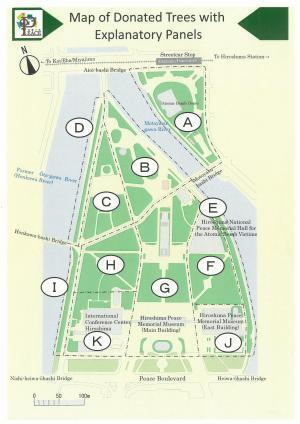
-
Map of Donated Trees with Explanatory Panels (PDF 361.8KB)

-
Map of Donated Trees (Block Map) (PDF 704.8KB)

-
Map of Donated Trees (Block A) (PDF 973.5KB)

-
Map of Donated Trees (Block B) (PDF 743.8KB)

-
Map of Donated Trees (Block C, D) (PDF 710.2KB)

-
Map of Donated Trees (Block E, F, J) (PDF 881.4KB)

-
Map of Donated Trees (Block G) (PDF 724.0KB)

-
Map of Donated Trees (Block H, I, K) (PDF 794.6KB)

-
Block A Rose Garden (Atomic Bomb Dome South) Arrangement Map (PDF 553.6KB)

-
Block B Rose Garden(Children’s Peace Monument) Arrangement Map (PDF 570.5KB)

-
Block A Rose Garden (Atomic Bomb Dome South) Photograph Collection (PDF 662.2KB)

-
Block B Rose Garden (Children’s Peace Monument) Photograph Collection (PDF 842.4KB)

Explanatory Plaque Design (High School Student Collaborative Project)
The explanatory plaque and logo were designed by five high school students: two second year students from Hiroshima Municipal Moto-machi High School and three second year students from Hiroshima Municipal Hiroshima Technical High School. The students reached their designs through discussions about how they felt during field-studies at Peace Memorial Park and what they wanted to express. Their design concepts are described below.
Explanatory plaque title
The title The Legacy of Peace Trees Donated from Home and Abroad was decided upon as a way to continue to covey our gratitude for donated trees for years to come.
Explanatory plaque design
Trees donated from overseas Trees donated from across Japan
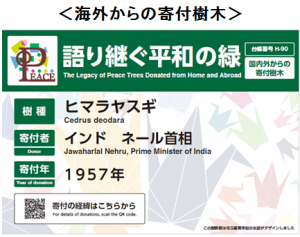
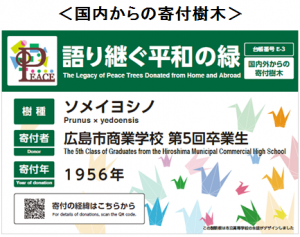
Rose Garden Roses
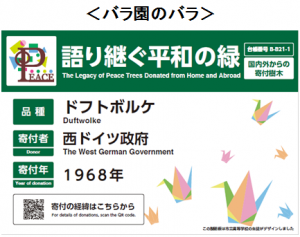
Design goals
Brightly colored paper cranes are a common sight throughout Peace Memorial Park, and while they are an example of traditional Japanese origami paper craft, nowadays they are seen as a symbol of peace, folded in many countries across the world as a prayer for peace. Hiroshima, known as the Peace Culture City, receives copious amounts of folded paper cranes every year from across Japan and the world.
The paper crane is used as a motif in the design of the explanatory plaques. Both the donated trees and paper cranes share a common concept: our wishes for peace and for connections with people across the globe. This concept is expressed through the vibrant composition of multicolored cranes. Furthermore, through the use of many large and small cranes in flight, the design expresses the desire for peace and the hopes for the future that are conveyed from Hiroshima.
Logo
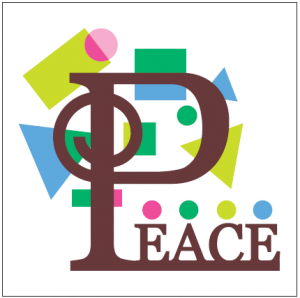
Design goals
The verdant green trees in Peace Memorial Park and along Peace Boulevard are symbols of peace and of restoration: they were donated from across Japan and from overseas to Hiroshima where it was said nothing would grow for 75 years following the bombing of our city.
Each and every tree conveys the wishes for peace from people the world over. They are a way for us who live in Hiroshima to deepen the friendships and connections we have with those who visit our city.
This logo employs the letters of the word Peace. The P represents the trunk of a tree and the E, A, C, and E represent people. In addition, the multicolored shapes express the human spirit of overcoming the differences of ethnicity, nationality, religion and culture, and coming together with mutual respect and compassion. It also expresses the spirit of devoting yourself to peace throughout your entire life.
Inquiries regarding this page
Flowers and Greenery Policy Section, Landscape Division, Greenery Promotion Department, Urban Development Bureau
1-6-34 Kokutaiji-machi, Naka-ku, Hiroshima
Tel 082-504-2396 // Fax: 082-504-2391
Email: [email protected]
The Legacy of Peace Trees Donated from Home and Abroad
PDFファイルをご覧いただくには、「Adobe(R) Reader(R)」が必要です。お持ちでない方はアドビシステムズ社のサイト(新しいウィンドウ)からダウンロード(無料)してください。
